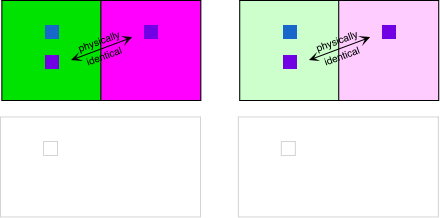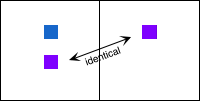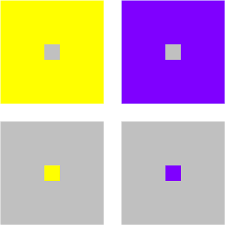Bezold effect (source)
The Bezold Effect is simply the fact that the substitution of a single color causes every other color in the design to shift in relationships. Changing just one color in a design changes the entire design in composition, personality, spatial perception and weight. When one color is changed, relationships between all colors in the design are altered. It is important to understand that the color relationships do not change evenly. Some colors will appear slightly lighter, or slightly darker, while others will appear significantly darker or lighter, or more saturated, or desaturated.
Informal: A Color can dictate changes in a composition and in addition, with the shifting of colors in a design composition will alter the entire composition.
simultaneous contrast (source)
Simultaneous contrast is demonstrated in the lower left panel. The three small squares are the same physical lights as in the top panel. The labeled squares are physically identical, and in the top panel they have roughly the same appearance. In the lower left panel, however, the pair that are physically identical have different color appearances due to the simultaneous contrast effects of the green and magenta backgrounds.
Informal: Some colors with different backgrounds will appear different based on the contrasting backgrounds. The colors will vary because of the background added value in the hue.
Color Interaction (Source)
Perhaps the most predominant property of color is its relative character. No color can be evaluated outside the environment in which resides. In his book “Color Interaction” author Josef Albers states that “the same color allows innumerable interpretations.” The same color may appear different when it is placed on other colors, and different colors may appear the same when placed on diverse other background colors.
Informal: Color is based on the background and it will transform and appear different when placed amongst other colors.







